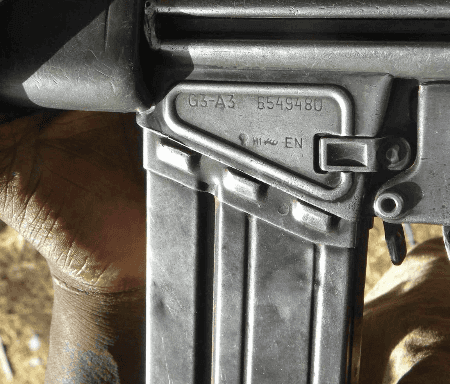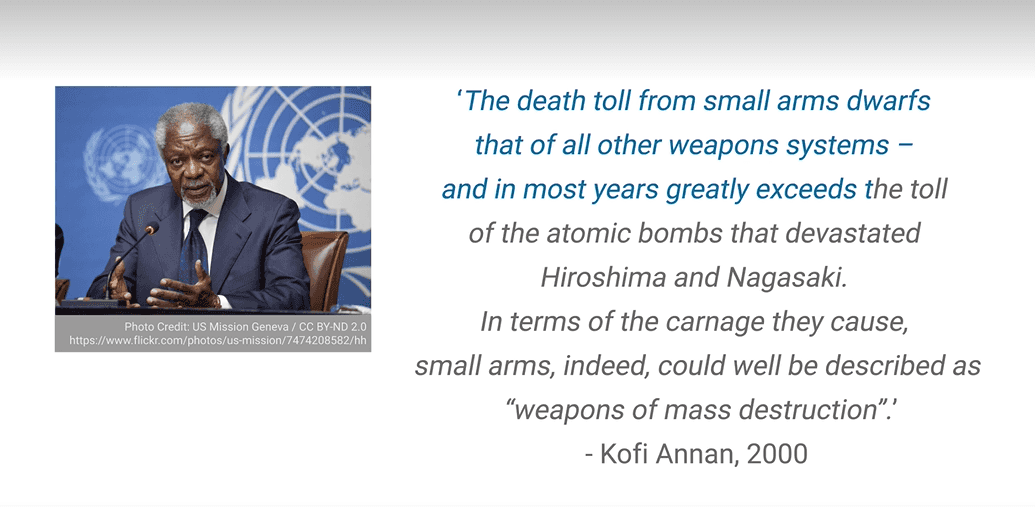Addressing the illicit proliferation of SALW

We will elaborate further on the ATT in the next chapter of this learning unit.
The Firearms Protocol
The Protocol against the Illicit Manufacturing of and Trafficking in Firearms, their Parts and Components and Ammunition was adopted in 2001 as an additional Protocol to the UN Convention against Transnational Organized Crime (November 2000). It entered into force in June 2005.
The Firearms Protocol does not apply to state-to-state transactions and state transfers in cases where the application of the Protocol would prejudice a state’s right to maintain national security as specified within the United Nations Charter.
The Firearms Protocol requires states parties:
- to adopt measures that criminalise illicit manufacturing and trafficking of firearms and criminalise tampering with the markings on firearms;
- to adopt measures that enable the confiscation and destruction of illicitly manufactured or trafficked firearms;
- to take measures for good record-keeping of illicitly manufactured or trafficked firearms;
- to mark firearms at the time of manufacture and of import;
- to prevent illicit reactivation of deactivated firearms;
- to establish or maintain an effective import, export and transit licensing system;
- to adopt security and preventive measures aimed at detecting, preventing and eliminating the diversion of firearms in its country;
- to confidentially exchange information on licit and illicit firearms activities among themselves;
- to cooperate at the bilateral, regional and international level, especially with regard to training and technical assistance;
- to consider establishing a system for the regulation of brokers.
The UN Programme of Action (PoA)
In July 2001, the UN Conference on the Illicit Trade in Small Arms and Light Weapons in All Its Aspects adopted the UN Programme of Action (PoA) to Prevent, Combat, and Eradicate the Illicit Trade in SALW. However, the PoA contains no specific mention of the issue of ammunition.
For further implementation of the PoA, states are asked to voluntarily submit national reports, convene biennial meetings and hold review conferences.
The PoA aims to prevent, combat and eradicate the illicit trade in SALW in all its aspects by:
- strengthening or developing agreed norms and measures at the global, regional and national levels that would reinforce and further coordinate efforts to limit the illicit trade in SALW;
- developing and implementing agreed international measures to limit the illicit manufacturing of and trafficking in SALW;
- placing particular emphasis on the regions of the world where conflicts are coming to an end and where serious problems with the excessive and destabilising accumulation of SALW must be dealt with urgently;
- mobilising political will throughout the international community to prevent and combat illicit transfers and manufacturing of SALW, to cooperate on achieving these goals and to raise awareness of the character and seriousness of the interrelated problems associated with the illicit manufacturing of and trafficking in these weapons;
- promoting responsible action by states with a view to preventing the illicit export, import, transit and retransfer of SALW.
The International Tracing Instrument (ITI)
In 2005, the UN General Assembly adopted the ITI which aimed to improve marking, record-keeping and tracing measures. More specifically, ITI aims to:
- enable states to identify and trace illicit SALW in a timely and reliable manner, by setting out a number of minimum requirements for marking and record-keeping;
- promote and facilitate international cooperation and assistance in marking, record-keeping and tracing;
- enhance the effectiveness of and complement existing bilateral, regional and international agreements to prevent, combat and eradicate the illicit trade in small arms and light weapons in all its aspects.
The ITI does not apply to antique SALW or their replicas.

Assessment
The Firearms Protocol, the UN PoA on SALW and the ITI remain very valuable international instruments in the ambition to prevent the illicit proliferation of SALW around the world.
The Firearms Protocol is still the only legally binding global instrument on firearms control. Since the Protocol’s entry into force, the international community’s approach to firearms control has evolved significantly. Many countries across the globe have now developed legislation to establish an export and import control system and to criminalise firearms trafficking. Many have also used the Firearms Protocol to implement measures for marking firearms, for improving record-keeping of seized firearms and for enhancing information sharing within national borders and with international partners.
The UN PoA on SALW is a soft law instrument that is characterised by a dynamic process of exchanging views and negotiation. Since its adoption in 2001, Review Conferences have been organised every six years. Two of the by-products of the PoA are the ITI and the recommendations of a Group of Governmental Experts on Brokering. In light of the 2018 Review Conference, the participating states renewed their commitment to prevent, combat and eradicate the illicit trade in SALW in all its aspects. They also reaffirmed the continued relevance of the PoA, stressed the importance of the full and effective implementation of the PoA to achieve the goals of the 2023 Agenda for Sustainable Development, and encouraged more transparency and better information exchange. Several specific steps needed to further implement the PoA were identified, including measures to prevent illicit manufacturing, reactivation and conversion of SALW. Special attention was also given to responding to the opportunities and challenges presented by recent developments in the manufacturing, technology and design of SALW.

